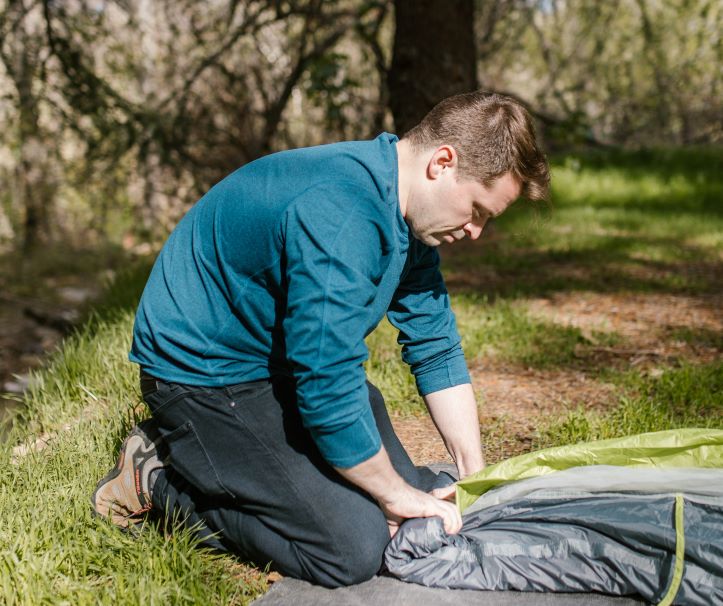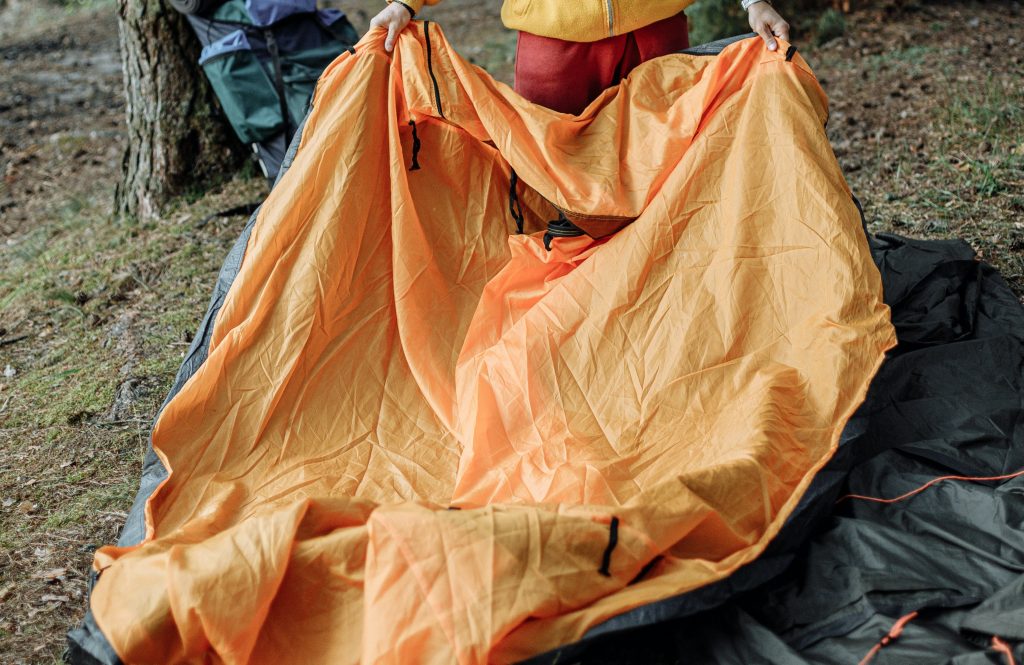A tent’s lifespan can be increased and its portability improved simply by folding it correctly. However, for those who have never camped before, folding the tent can be a bit of a difficulty. Because of this, we’ve compiled this manual to teach you how to fold a tent properly.
This post will provide you a high-level overview of how to fold a tent and why it’s crucial to do so properly. Your tent will always be ready for your next camping trip if you follow the steps in this article and learn how to fold it up quickly and efficiently. Okay, so let’s get going!
Understand Tent Components
Identify Tent Poles, Rainfly, and Stakes
You need to know your tent and how it’s put together inside and out to be an expert tent-folder. First, let’s break down the fundamentals:
Tent Poles: Tent poles are the upright structures that allow a tent to stand upright. They are often built of aluminum or fiberglass because of their minimal weight. Tent poles often consist of separate sections that are linked together using shock cords, making set up and take down a breeze.
Rainfly: The rainfly is a waterproof membrane that encloses the main tent. It’s a protective covering that keeps the wind, rain, and snow at bay. Waterproof fabrics like nylon or polyester are common for rainflies, and they typically have straps for a snug fit.
Stakes: Tent stakes are the heavy-duty pegs that secure your shelter to the ground. They are crucial for security, especially in gusty weather. Aluminum and steel are the most popular materials for stakes, and they come in a wide variety of shapes, including the familiar Y and V.
ExploreDifferent Tent Designs
To meet the needs and interests of different campers, tents are available in a variety of styles. Some common categories include:
Dome Tents: Dome tents have two or more intersecting poles that create a dome shape. You can take the whole family camping in one of them because of how stable it is and how much space there is inside.
Cabin Tents: Cabin tents have walls that are both straight and tall, giving them the appearance of a miniature cabin. They are ideal for car camping and large group excursions because to their high ceilings and spacious layout.
Tunnel Tents: Tunnel tents include lengthy, tunnel-like structures with arched poles. They are lightweight, making them perfect for travellers who value portability and convenience.
Instant Tents: Tents that can be built up quickly are known as instant tents. Since the poles are already attached, setting up one of these tents is a breeze, making them ideal for last-minute camping trips.
Prepare the Tent to Fold
Before you can start folding your tent, it’s important to prepare it for storage. Here are the steps you should follow:
Clean the tent: Make sure the tent is clean and clutter-free before you begin folding it. Any dirt, leaves, or other debris that may have gathered on the tent during your camping vacation can be easily swept away using a broom or brush. Any soiled sections of the tent can be cleaned with a moist cloth.
Remove any accessories: Take down your tent, and then take down any guylines, stakes, or rainfly that might be attached to it. When packing up the tent, these items can get in the way and should be removed in advance.
Clear the area around the tent: Make sure there are no furniture or other obstructions inside the tent’s immediate vicinity. There will be plenty of room to work with, and the tent will be protected from harm, if you do this.

Major Steps to Fold the Tent
Once you’ve prepared your tent for folding, you can start the process of actually folding it. Here are the steps you should follow:
Remove the stakes and guylines
The first step in folding a tent is to remove any remaining stakes or guylines. This will make it easier to fold the tent and will prevent any damage to the tent.
Fold the tent in half lengthwise
The tent should be folded in half lengthwise after the stakes and guylines have been taken down. The tent’s ends must be brought together, with the corners aligned, to achieve this.
Fold the tent in half widthwise
Then, bring one side of the tent to the opposite side, folding it in half widthwise. Fold the tent properly, ensuring that the corners are aligned.
Roll the tent tightly
You can now roll the tent up from one end to the other after having folded it in half lengthwise and widthwise. Tent must be rolled securely and uniformly, with no creases or wrinkles in the cloth.
Tips for Storing the Tent
After folding your tent, it’s important to store it properly to ensure that it stays in good condition for your next camping trip. Here are the steps you should follow:
Place the tent in a storage bag: The first step in storing your tent is to place it in a storage bag. This will help to protect the tent from dust, dirt, and other debris, and will also make it easier to transport. Make sure that the storage bag is large enough to accommodate the tent, and that it’s made from a breathable material that will allow air to circulate.
Store the tent in a cool, dry place: The tent should be stored in a cool, dry location after being removed from its storage bag. This will prevent the tent from getting mildewy and moldy and increase its useful life. Tent fabric can easily be damaged by exposure to high levels of moisture, therefore keep it out of damp or humid storage areas.
If you want to enhance the durability & performance of your tent, you can do PU Coating on your tent. Also, you can buy one which is PU Coated. Know more about What Is A Pu Coating.
How to Pack the Tent into a Carry Bag?
Efficiently Pack the Tent and Accessories
As your camping adventure comes to an end, proper tent packing ensures a stress-free departure. Follow these tips for efficient packing:
Clean and Dry: Before packing, make sure your tent is clean and dry. Shake off any debris and wipe down surfaces to prevent mold and mildew growth.
Organize Components: Gather all tent components, including poles, rainfly, and stakes. Keep them together to avoid losing any pieces.
Fold or Roll: Depending on your tent’s size and shape, choose to fold or roll it. Rolling may work better for dome tents, while cabin tents might be easier to fold.
Pack Loosely: Avoid overstuffing the carry bag. Loosely pack the tent to prevent unnecessary pressure on zippers and seams.
Utilize Compartments: Some carry bags come with extra compartments. Utilize these pockets to store small accessories like repair kits and guylines.
Choose the Right Storage Technique
Properly storing your tent between trips ensures its longevity and performance. Consider these storage techniques:
Dry and Cool Location: Store your tent in a cool, dry, and well-ventilated area. Avoid long-term exposure to direct sunlight, as UV rays can degrade tent materials.
Hang or Lay Flat: If possible, hang the tent or lay it flat rather than folding it for extended storage. This helps maintain the tent’s shape and reduces creases.
Use a Stuff Sack for Short-Term Storage: For short breaks between camping trips, using a stuff sack is convenient and saves space.
Long-Term Storage in a Larger Bag: For longer periods, use a larger, breathable storage bag that allows the tent to breathe and prevents moisture buildup.
How to Troubleshoot Tent Folding Issues?
Deal with Stuck Zippers and Snags
Stuck zippers can quickly turn a simple task into a frustrating ordeal. To avoid getting zipped out of your tent, follow these tips:
Lubricate the Zipper: Apply a silicone-based zipper lubricant or use candle wax to make the zipper glide smoothly.
Avoid Overstuffing: Overstuffing the tent bag can put pressure on the zipper, leading to snags. Pack your tent carefully to prevent this issue.
Straighten the Fabric: Ensure the fabric around the zipper is straight and not caught in the teeth. Gently pull the fabric to release any snags.
Handle Wet or Dirty Tents
Camping adventures often lead to encounters with mud and rain. When dealing with wet or dirty tents, consider the following:
Dry the Tent Properly: If possible, dry the tent before packing it away. Hang it in a shaded area to prevent UV damage, and avoid storing it while damp to prevent mildew.
Clean the Tent: Use a soft brush or cloth to remove dirt and debris. Avoid harsh detergents or bleach, as they can damage the tent’s waterproof coating.
Consider Footprint or Ground Cloth: Using a footprint or ground cloth beneath the tent can protect it from moisture and debris, making cleaning and drying easier.
Fix Bent or Misaligned Tent Poles
Bent or misaligned tent poles can disrupt the setup process. Here’s how to address this issue:
Gently Straighten Bent Poles: If a pole becomes bent, carefully bend it back into its original shape. Applying too much force may cause the pole to snap.
Check for Proper Fit: Ensure the poles are securely inserted into the corresponding grommets or sleeves. Adjust as needed to achieve the correct alignment.
Carry Repair Supplies: Pack a tent repair kit with splints and pole repair sleeves to handle any on-site pole emergencies.
Conclusion
Anyone who goes camping has to know how to set up, take down, and store a tent. If you follow the advice in this article, you can keep your tent in pristine shape, extending its life and making it always ready for your next camping trip. Fold your tent carefully and store it in a cool, dry area to extend its life and avoid damage. If you treat your tent with respect, it should last you for many years of camping adventures. Get out there and enjoy nature, but remember to put away your tent the right way when you’re done camping.
